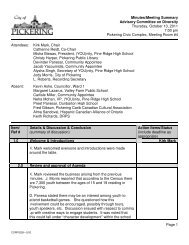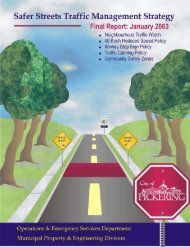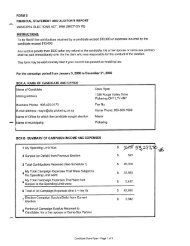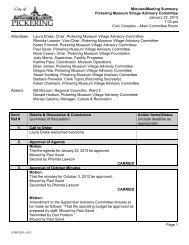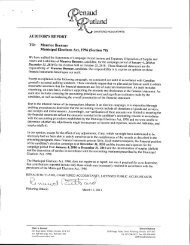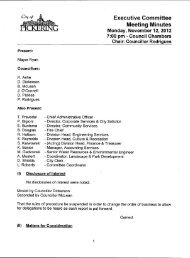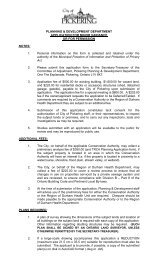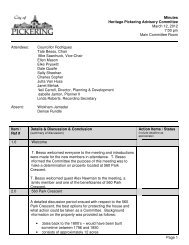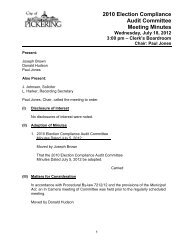Chapter A - Introduction - City of Pickering
Chapter A - Introduction - City of Pickering
Chapter A - Introduction - City of Pickering
You also want an ePaper? Increase the reach of your titles
YUMPU automatically turns print PDFs into web optimized ePapers that Google loves.
COMMENT MESPA RESPONSE (December 2011) CITY RESPONSE (October 2012) RESPONSE<br />
use and ownership <strong>of</strong> the asset are <strong>of</strong>ten greater than the original design<br />
and construction costs and may vary significantly between alternative<br />
solutions. The CPDP’s Servicing goal was quite clear in its specific<br />
objective <strong>of</strong> minimizing life cycle costs.<br />
REPORT CHAPTER<br />
AND SECTION<br />
The experience <strong>of</strong> GTA municipalities has been that the continued<br />
operations and maintenance <strong>of</strong> end-<strong>of</strong>-pipe facilities is a significant<br />
financial and environmental liability for the municipality. This issue is<br />
imperative to the <strong>City</strong> <strong>of</strong> <strong>Pickering</strong> as the 69 proposed end-<strong>of</strong>-pipe<br />
facilities is an enormous addition to our existing stormwater management<br />
infrastructure (an increase <strong>of</strong> approximately 350% <strong>of</strong> the number <strong>of</strong> ponds<br />
than are currently present in the municipality). Furthermore, the current<br />
state <strong>of</strong> stormwater management practice is to use preventative and<br />
distributed approaches to managing stormwater through source and<br />
conveyance control measures with end-<strong>of</strong>-pipe facilities only being<br />
considered when all other options have been exhausted.<br />
Additionally, from a municipal operations standpoint, how the different<br />
types <strong>of</strong> stormwater management facilities are maintained varies greatly.<br />
Maintenance <strong>of</strong> LID type facilities can be accomplished by current<br />
operations staff, whereas, stormwater management pond cleanouts are<br />
very time consuming, require an extensive approval process including<br />
expertise that the <strong>City</strong> would have to retain through outside services.<br />
<strong>Chapter</strong> C – Transportation<br />
COMMENT<br />
RESPONSE<br />
REPORT CHAPTER<br />
AND SECTION<br />
Steeles Avenue East<br />
“A 1992 Municipal Engineer’s Association (MEA) Class Environmental Assessment (MEA<br />
Class EA) study <strong>of</strong> Steeles Avenue East between the Durham Boundary and McCowan<br />
Road, approved a widening <strong>of</strong> Steeles Avenue East to four lanes and allowed the <strong>City</strong> to<br />
undertake various improvements alone.”<br />
This section <strong>of</strong> the MESPA refers to a 1992 Municipal Engineers Association (MEA) Class<br />
Environmental Assessment (MEA Class EA) study <strong>of</strong> Steeles Avenue East between the Durham<br />
Boundary and McCowan Road, which approved a widening <strong>of</strong> Steeles Avenue East to four<br />
lanes.<br />
Additionally, the Durham-Toronto-York Transportation Study also recommended widening <strong>of</strong><br />
Steeles Avenue East from 2 to 4 lanes in the short term. <strong>City</strong> staff recognizes that the Steeles<br />
Avenue East is outside <strong>of</strong> the Seaton boundary, however there is a critical need to widen<br />
Steeles Avenue East between Markham Road and Durham boundary to accommodate future<br />
traffic needs <strong>of</strong> Seaton. The MESPA document does not include any recommendation to widen<br />
Steeles Avenue. Therefore, <strong>City</strong> staff recommends that the recommendation for widening <strong>of</strong><br />
Steeles Avenue be included in the document.<br />
This section <strong>of</strong> the report records previous reports and studies and is not an appropriate location for our comments and<br />
recommendations. Steeles Avenue is discussed in more detail in the October 2012 SSIS.<br />
The ultimate timing for the widening <strong>of</strong> Steeles Avenue west <strong>of</strong> the York-Durham border will be the subject <strong>of</strong> additional study to be<br />
completed as a condition <strong>of</strong> development beyond Phase 1 <strong>of</strong> Seaton if the widening is not advanced before Phase 1 is substantially<br />
built out. Funding <strong>of</strong> the project will require inter-governmental and agency agreements to be completed which is beyond the scope and<br />
Terms <strong>of</strong> Reference for this MESPA.<br />
<strong>Chapter</strong> C1.3.2.1<br />
MEA Class EA Requirements<br />
The MESPA provides specific recommendations for arterial and collector roads within Seaton<br />
<strong>Chapter</strong> A provides an overview and clarification <strong>of</strong> the MEA Class EA requirements/interpretation as noted above in the response to<br />
<strong>Chapter</strong> C2<br />
The Sernas Group Inc., Stonybrook Consulting Inc. December 2011, Revised February 2013 Master Environmental Servicing Plan - Amendment<br />
SPL Beatty, Bird and Hale Limited, Earthfx Inc. 07161 Seaton Community, <strong>City</strong> <strong>of</strong> <strong>Pickering</strong><br />
AMEC Earth & Environmental, R.J. Burnside Appendix A7 – Page 16<br />
Amos Environment + Planning



